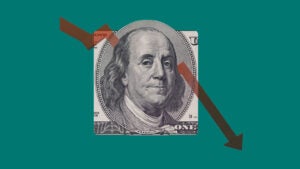How to achieve financial freedom: 9 steps toward financial independence



If you’re like many people, you dream about reaching a point where you don’t have to worry about money, and you can quit your 9-to-5. According to Bankrate’s recent Financial Success Survey, 41 percent of Americans would consider themselves financially successful when they never worry about their finances.
Most Americans say they wouldn’t feel secure until they’ve made at least $233,000 a year, according to Bankrate’s Financial Freedom Survey. To feel rich and financially free, Americans said they would need to earn an average of $483,000 a year.
Fortunately, it’s possible to achieve financial freedom. With careful planning, disciplined savings and wise investments, you can reach your goal. Here’s how you can become financially independent.
What is financial freedom?
Financial freedom means different things to different people. Some define it as never having to work again, while others say being financially free means eliminating debt.
Among Bankrate’s Financial Success Survey, 19 percent of Americans say having enough money to quit working represents financial success while 41 percent say living without debt fulfills this goal.
“Financial freedom describes having enough wealth to live without having to work actively for necessities,” says Dennis Shirshikov, head of growth at gosummer.com and finance professor at the City University of New York. “It means having the means to afford the lifestyle you want for yourself and your family.”
“Achieving financial freedom allows you to make decisions that are not solely based on financial constraints,” Shirshikov adds. “For example, you can choose to pursue passions, hobbies or even career changes without worrying about the financial repercussions.”
What is the FIRE movement?
The Financial Independence, Retire Early (FIRE) movement is a lifestyle and financial strategy that aims to achieve financial independence and early retirement. The goal is to save and invest enough money to provide a sustainable income for the rest of one’s life, allowing for retirement at a much earlier age than the traditional retirement age.
FIRE gained attention after the publication of the book Your Money or Your Life by Vicki Robin and Joe Dominguez. The movement emphasizes assessing each purchase by analyzing the working hours needed to make the purchase.
Followers of the FIRE movement typically aim to save 50 percent to 70 percent of their annual income and plan to retire when their savings reaches around 30 times their yearly expenses, or roughly $1 million. Once retired, they make small annual withdrawals (usually around 3 percent to 4 percent) from their savings to cover living expenses.
“One would have to live significantly below their means and be aggressive when it comes to their asset allocations,” says Steven Charlton, certified financial fiduciary and founder of Wisdom Financial. “The FIRE movement can be utilized to find financial freedom by growing assets proportionately in order to be able to live off interest and dividends. This way you won’t have to live off the income when you decide to retire.”
How to create financial freedom
Achieving financial freedom involves careful discipline and planning. The following steps can help you reach this milestone.
Create financial goals
Creating financial goals is necessary for achieving financial freedom. Start by setting specific, measurable and time-oriented (SMART) goals. Instead of aiming to just save money, set a goal to save $10,000 in a year, for example.
Distinguish between short-term (within a year), medium-term (around five years) and long-term (more than five years) goals. This helps you decide the type of savings and investment strategies to use for each goal. Maintaining a budget, saving for emergencies and retirement and paying down debt should be part of your plan.
“One of the biggest mistakes when trying to achieve financial freedom is failing to plan,” says attorney and certified public accountant, Mark Pierce, founder of Wyoming Trust and LLC Attorney. “Planning for the future is essential in the context of financial freedom.”
Optimize your budget
Some ways to optimize your budget include tracking and analyzing your expenses, finding ways to cut costs, living below your means and meal planning. Start by keeping a record of your spending habits. Monitoring every expense, even small ones, will help you understand where your money goes.
Once you have a better understanding of your spending habits, identify areas where you can cut costs. Create a budget that prioritizes spending on necessities and limits spending on non-essentials. For meal planning, create a shopping list based on your meal plan and stick to it to avoid impulse purchases.
Chartered financial consultant Steve Azoury, owner of Azoury Financial, warns against overdoing things when it comes to creating a spending plan. If your budget is overly restrictive, this could tempt you to spend more.
“Financial freedom doesn’t have to be so extreme in nature,” says Azoury. “When it comes to financial freedom, many may fail due to the temptations of buying and spending that we all enjoy. It’s best to avoid overdoing it by incorporating some ideas of financial freedom, but not in such an extreme manner as FIRE that may be unsustainable.”
Tackle debt
Start by taking a debt inventory. Get an understanding of the total amount you owe. This can help you visualize a repayment plan.
“Reducing debt, particularly high-interest debt like credit cards, is crucial,” says Shirshikov. “Overleveraging on debt, particularly for depreciating assets, can hinder progress toward financial freedom.”
Pay off debts with the highest interest rates first, known as the debt avalanche method, or start with the smallest debts to gain quick wins, known as the debt snowball method.
Also, consider paying more than the minimum and making payments more than once a month to reduce the principal faster. Embrace small savings by cutting unnecessary expenses and redirecting those funds toward your debt.
Prioritize investing and saving
Start by listing all your financial goals and determining how much you need for each. Rank these goals by importance, focusing on needs first, such as saving for retirement, paying off high-interest debt and setting up an emergency fund. Bankrate’s Annual Emergency Savings Report found that just under 6 in 10 (59 percent) U.S. adults are uncomfortable with their emergency fund.
Begin investing according to the time horizon of your goals. For short-term goals, use low-risk investments like savings accounts or certificates of deposit (CDs). For medium-term goals, consider a mix of bonds and stocks. For long-term goals, focus on higher growth potential investments like stocks.
Arrange automatic transfers from your paycheck to your savings and investment accounts to make sure you’re contributing consistently. Regularly review your portfolio, and rebalance it to maintain your target allocation.
See more: Best CD rates
Increase your income
The quickest ways to increase your income are negotiating a raise with your current employer or seeking employment that offers higher pay. A side hustle can also add an income stream. This can be anything from freelance work to consulting or starting a small business.
If you have access to a company 401(k), take advantage of your employer’s match, which is essentially free money. It’s important to understand the vesting schedule and contribute enough to get the full match.
Choose the best savings accounts for your situation
Choosing the best savings account for your situation depends on your financial goals, flexibility needs and the time frame for accessing your funds. High-Yield Savings Accounts are ideal for emergency funds due to their above average interest rates and quick, penalty-free access to cash. As of this writing, the top rate among banks we monitor is 5.30 percent, which is offered by BrioDirect.
Money market accounts (MMAs) are suitable for medium-term goals as they offer higher yields than regular savings accounts and provide liquidity with check-writing privileges and debit cards. Although shorter terms are available, certificates of deposit (CDs) are best for long-term savings goals where you can lock your money away for a fixed period in exchange for a higher interest rate. Health savings accounts (HSAs) and retirement accounts, such as a 401(k), offer tax advantages and can be part of a broader savings strategy.
Read next: Best money market accounts
Explore passive income ideas
Earning passive income can be a strategic way to generate additional cash flow with minimal ongoing effort. While it often requires an initial investment of time, money or both, the returns can be worthwhile over the long term.
“Passive income is money earned with little to no effort, as opposed to active income, which includes salaries, wages, tips or commissions that are earned from physically working at a specific job,” says RentRedi Co-founder and CEO Ryan Barone. “For example, when you accrue interest on money in a high yield savings account, you are doing nothing to earn this passive income.”
Barone says one of the best ways to earn passive income is by renting out property. He recommends starting small and then building from there.
“You can start small by renting out extra space in the home you currently live in,” Barone tells Bankrate. “This is called house hacking, and usually involves renting out extra bedrooms in your home. But you can also rent out other spaces such as garages, attics, basements, yards, driveways, closets or sheds for storage or parking spaces.”
Analyze big-ticket purchases carefully
Deciding whether to purchase a big-ticket item requires careful planning. Consider the impact of large purchases, such as a home, a new car and a wedding.
For all purchases, it’s best to observe a waiting period so that you can avoid impulse buying. You can also use this time to look for deals and discounts. Taking a step back will help make an informed decision and ensure your purchase meets your financial goals.
Keep learning about personal finance
Building financial literacy can help you manage, save and invest money effectively. Subscribe to financial newsletters, listen to financial podcasts, read personal finance books and follow financial experts on social media.
Also, consider meeting with a financial professional for personalized advice. Being proactive in these areas can boost your financial literacy and help you make better financial decisions.
Bottom Line
Achieving financial freedom is possible with careful planning. It means having enough savings and investments to afford the lifestyle you want without worrying about your finances. By taking the proper steps, you can master your finances and achieve financial independence.
Why we ask for feedback Your feedback helps us improve our content and services. It takes less than a minute to complete.
Your responses are anonymous and will only be used for improving our website.




